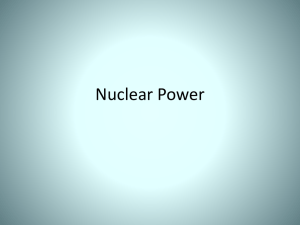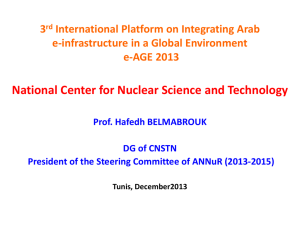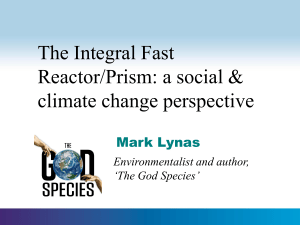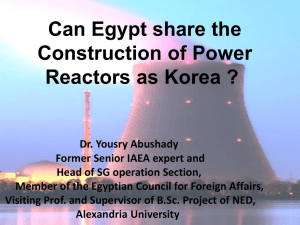The Progress of P&T activities in China(Xia Haihong, Zhao Zhixiang)
advertisement
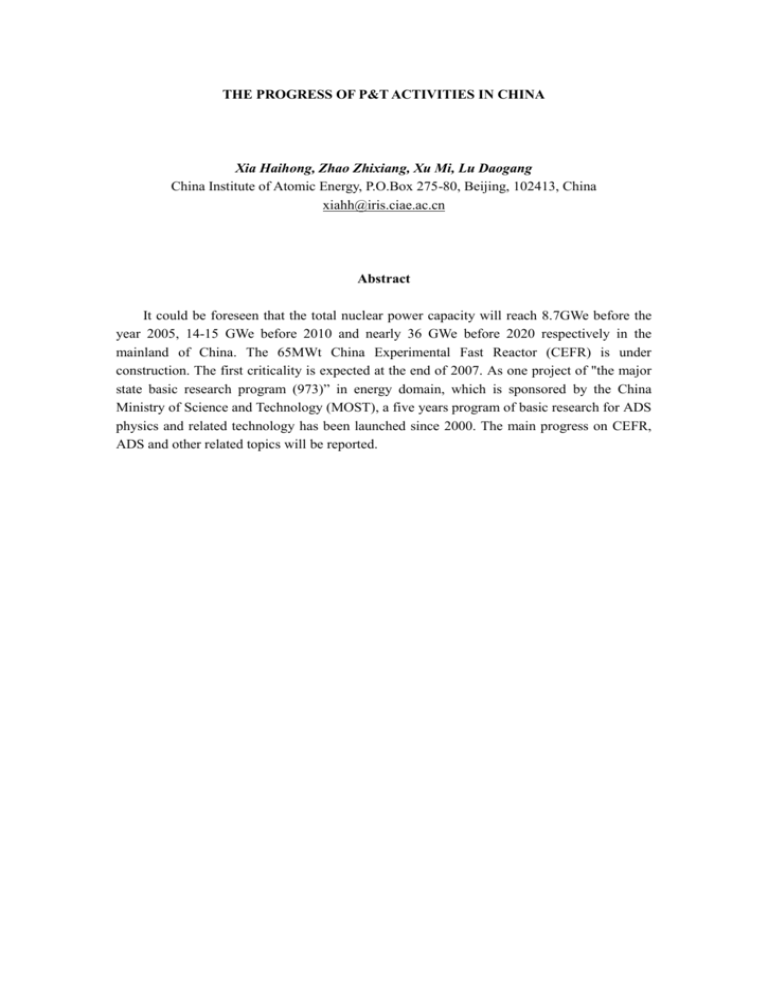
THE PROGRESS OF P&T ACTIVITIES IN CHINA Xia Haihong, Zhao Zhixiang, Xu Mi, Lu Daogang China Institute of Atomic Energy, P.O.Box 275-80, Beijing, 102413, China xiahh@iris.ciae.ac.cn Abstract It could be foreseen that the total nuclear power capacity will reach 8.7GWe before the year 2005, 14-15 GWe before 2010 and nearly 36 GWe before 2020 respectively in the mainland of China. The 65MWt China Experimental Fast Reactor (CEFR) is under construction. The first criticality is expected at the end of 2007. As one project of "the major state basic research program (973)” in energy domain, which is sponsored by the China Ministry of Science and Technology (MOST), a five years program of basic research for ADS physics and related technology has been launched since 2000. The main progress on CEFR, ADS and other related topics will be reported. Introduction China, as a developing country with a great number of population and relatively less energy resources, reasonably emphasizes the nuclear energy utilization development. Due to the economy and experience reasons, the nuclear power and technology development with a moderate style are kept in China up to now. Presently, in the mainland of China, there are nine reactor units in operation at five NPP sites with the total capacity of 6.7 GWe; two units at one NPP site are under construction, and two NPP sites are planned within the frame of the Tenth Five-year Plan (2001-2005) as shown in Table 1. Also, another one or two NPP sites are still under discussion. It can be foreseen that the total nuclear power capacity will reach 8.7 GWe before the year 2005, 14-15 GWe before 2010, and nearly 36 GWe before 2020, respectively. NPP Qinshan-1 Daya Bay Qinshan-2 Qinshan-3 Lingao-1 Lian yungang Sanmen Lingao-2 Yangjiang TABLE 1 MAINLAND NUCLEAR POWER PLANTS Type Power (MWe) Commercial operation PWR 300 1993 PWR Jan. and Jun. 1994 2×900 PWR Apr. 2002 and May 2004 2×600 PHWR Dec. 2002 and Jul. 2003 2×728 PWR May 2002 and Mar. 2003 2×984 PWR 2004 and 2005 2×1000 PWR 2010 (to be expected) 2×1000 PWR 2010 (to be expected) 2×1000 PWR 2010 (to be expected) 2×1000 To develop nuclear power in large scale, two problems must be solved. First, as we understand the technically and economically exploitable natural uranium resources are limited domestically or overseas, so the uranium utilization rate has to be raised greatly. Second, long-lived radioactive nuclear wastes have to be in disposal to reduce its impact to environment and public fear to nuclear power. Right now only small amount of spent fuels from NPPs has been accumulated in China. But the situation will be very serious in the future according to above prediction of nuclear energy development in China. The annual generation of waste is estimated to 2 275, 7 500 and 10 000 m3 respectively for the year 2004, 2010 and 2020. Considering MA and LLFP transmutation with more efficiency and non-criticality risk for new nuclear application, the fast breeder reactor technology and the accelerator-driven sub-critical system (ADS) have been started to develop as a national research projects in China. Fast reactor technology development in China [1-3] For the continuously development of nuclear energy and the effective utilization of the uranium resource, the development of fast breed reactor in China was started early in 1965. The basic researches for FBR in China could be divided into two Phases. The activities from the middle-end of 60s to the year 1987 focus on fast neutron physics, thermohydaulics, materials, sodium technology and some sodium components in small size. During this period about 12 sodium loops and test facilities have been built up including a fast neutron zero power facility DF-V containing 50 kg 235U. From the year 1987 to 1993, all research activities were arranged with a target of 65 MWt experimental fast reactor. The emphasis was put on fast reactor design study, sodium technology, and fast reactor safety, fuels and materials as well as sodium components. During this period about 20 sodium loops and testing facilities have been established and tested. After above period’s researches the R&D of fast reactor technology are carried out as the design demonstration tests which more than 30 items. The 65 MWt China Experimental Fast Reactor (CEFR) supported by the National High Technology Programme (863) is under construction. The conceptual design of the CEFR was started at 1990 and completed at 1993 including the confirmation and optimization to some important design characteristics. Its preliminary design was completed in August 1997. The detail design was started since the early 1998. In May 2000 approval of the construction was issued and the first barrel of concrete was poured. The construction of reactor building (57 meters above the ground) with about 40,000m2 floor surface was completed in August 2002. CEFR is a sodium cooled 65MWt experimental fast reactor with (Pu, U)O2 as fuel, but UO2 as first loading, Cr-Ni austenitic stainless steel as fuel cladding and reactor block structure material, bottom supported pool type, two main pumps and two loops for primary and secondary circuit respectively. The water-steam tertiary circuit is also two loops but the superheat steam is incorporated into one pipe which is connected with a turbine. Table 2 shows the main design parameters of CEFR. The final safety analysis report (FSAR) is being prepared. Much progress was made with regard to the topics required by the nuclear safety authority. Almost all the safety-related design demonstration tests have been carried out. The detailed design work is nearly completed (about 95%), except for the instrumentation and control (I&C) system. 90% of the concrete constructions, including the main building, have been completed. About 300 components have been installed in the building. The steel liner and the ventilation pipes are being installed. Components and instruments made in domestic companies are fabricated smoothly and delivered to the site continuously, except for the main vessel, whose delivery is postponed by 2 years due to the delays in material procurements and the shortage of production capacity at the manufacturer. Some components and instruments imported from foreign companies, for example the control rod drive mechanisms (CRDM), the in-vessel fuel handling machines, the sodium valves, and others, have been delivered to the site. TABLE 2 CEFR MAIN DESIGN PARAMETERS Parameter Thermal Power Electric Power, net Reactor Core Height Diameter Equivalent Fuel Linear Power max. Neutron Flux Bum-up, target max. Bum-up, first load max. Inlet Temp. of the Core Outlet Temp. of the Core Diameter of Main Vessel(outside) Primary Circuit Number of Loops Quantity of Sodium Flow Rate, total Number of IHX per loop Secondary Circuit Number of loops Quantity of Sodium Flow Rate Tertiary Circuit Steam Temperature Steam Pressure Flow Rate Plant Life Unit MW MW Preliminary design 65 20 cm cm 45.0 60.0 (Pu, U)O2 430 3.7×1015 100000 60000 360 530 8.010 W/cm N/cm2·s MWd/t MWd/t ℃ ℃ M T t/h 2 260 1328.4 2 T t/h 2 48.2 986.4 ℃ MPa t/h A 480 14 96.2 30 The general program, the quality assurance guideline, and the schedule for the pre-operation testing have been defined. The testing procedure, testing guideline and testing safety criteria for each system are under preparation. For the physics start-up, the test list and test methods have been determined, and the related instruments and equipments have been ordered. In particular, the fast neutron zero-power reactor DF-VI has been moved to Beijing and will be used for operator training, demonstration of the experimental neutron physics methods, as well as for neutron detector testing. Presently, 28 operators, including 4 senior operators, are being trained. Due to the delay in the delivery of the reactor main vessel, the project schedule has been updated. The first criticality, originally planned for the end of 2005, is now postponed to the end of 2007. The 600 MWe Chinese Prototype Fast Reactor (CPFR) is being considered, and the submittal of the relative proposal to the government is being been considered. Progress in ADS system research The conceptual study of Accelerator Driven System (ADS) [4] had lasted for about five years and ended in 1999 in China. As one project of "the major state basic research program (973)” in energy domain, which is sponsored by the China Ministry of Science and Technology (MOST), a five years program of basic research for ADS physics and related technology has been launched since 2000. The research activities are focused on HPPA physics and technology, reactor physics of external source driven sub-critical assembly, nuclear data base and material study [5]. For HPPA, a high current injector consisting of an ECR ion source, LEBT and a RFQ accelerating structure of 3MeV will be built. A 1GeV/20mA linac is in the conceptual study [6]. In reactor physics study, a series of neutron multiplication experimental study has been carried out and is being carrying on. Instead of the verification facility consisted of a 150MeV/3mA linac and a modified swimming pool light water reactor of 3.5 MW described in [4], a rather modest but more realistic facility is in consideration. CIAE (China Institute of Atomic Energy), IHEP (Institute of High Energy Physics), PKU-IHIP (Institute of Heavy Ion Physics in Peking University) and other institutions are jointly carrying on above mentioned research. DongFeng 3 experiment DongFeng 3 is an existing light water moderated zero power critical assembly with flexible core structure. We re-arranged the core-structure loaded with 20% enriched U3O8 fuel pin with 400mm active length packed in φ6 aluminum tube of 1 mm thickness. On this arrangement the nuclei number ratio NH/N5 is about 270. A strong 252 Cf neutron source of 2×109n/sec is used in the experiment. In central area of the core, there is the buffer. Water, lead and stainless steel are used as buffer material respectively. Experimental measurements of keff in sub-critical mode were carried out with different buffers by using source jerk and extrapolation-period method. The measurements of spatial distribution of fission rate and neutron flux have been done by means of a solid state nuclear track detector (SSNTD). The measurements were carried out both in critical and sub-critical modes with 252Cf neutron source with different buffer materials. In sub-critical mode, the source position was at the center of the core and at the button of the structure respectively. Venus Ⅰ Experiment A composed structure of zero-power sub-critical assembly combined with a pulsed neutron source, Venus Ⅰ program is being carrying on followed the DongFeng 3 experiment. The pulsed-neutron will be provided by a Cockroft-Walton machine, routinely operated since 2001. 14MeV and 2.5 MeV neutron will be derived by d-T and d-D reaction. The neutron yield in DC mode can reach 1012n/s, while in micropulse mode 109n/s~1010n/s for d-T reaction. There are source and buffer in the centre, a driven zone consisted of natural Uranium pin is very densed lattice with aluminum in between, an active zone with 20% and mainly 3% enriched 235U fuel pin is polyethylene lattice and the polyethylene reflector. Different neutron spectra in different zone are expected. The buffer will shift the sharp 14 MeV and 2.5 MeV neutron to the fast neutron spectra to mock-up the evaporation bump in the spallation neutron spectrum and fission spectrum as possible as. In the driven zone not much neutron multiplication is to be expected, while the hard neutron spectra with average energy about 700 keV is expected. In the active zone the thermal neutron is expected. The assembly will be operated in deep sub-criticality keff ≈0.90~0.98 range. The neutron importanceφ*, keff, spatial distribution of neutron flux, neutron spectra and fission rate will be measured for d-T and d-D source respectively. Intense Proton Ion Source An electron cyclotron resonance (ECR) ion source is selected for the source of our verification facility system. The microwave power generated by a 2.45GHz-1kW magnetron is coupled into the copper chamber (5472 mm in cross section and 36 mm long) through a three stubs tuning unit and a ridged wave guide. Inside the chamber, a 54 mm in diameter quartz tube which is tightly fixed by a BN disk and a plasma electrode is placed to confine the plasma. A BN plate is placed between the ridged waveguide and plasma chamber to separate the plasma and vacuum. Three holes are made on the waveguide to evacuate the wave guide after the microwave window; with this configuration the gas in the waveguide can be evacuated quickly to avoid interfering the discharge. The microwave window for vacuum sealing is placed behind a bend section in order to avoid any damage due to the back streaming electrons. The microwave system including its power supply is placed on the 75kV high voltage platform. A 65 mA hydrogen beam can be routinely extracted from a 6.5 aperture of the source. The emittance of the extracted beam is measured by a multi-slits and single thread emittance-measuring unit. The measured emittance of the total beam at 60 mA, 60 kV, 50 cm downstream of the ion source is 0.129πmm.mrad. At a specific extraction distance, an adequate extraction voltage always can be found for various beam currents to obtain minimum emittance. The proton ratio is measured by analyzing a portion of the beam with a mini-deflection magnet. The result shows that proton fraction is more than 80% which satisfied the requirement of the system. The proton fraction slightly varies with the changes of microwave power but no significant effect is found. The more stringent request concerning the reliability test have been investigated. There are three breakdowns in the 121 hours test, first 2 breakdowns occur at first 5 hours and the last one occurs 2 hours to the end of the test. All three breakdowns caused by self-protection of the power supply of magnetic coils. The beam is restored in one minute by simply restarting the power supply each time. The longest uninterrupted beam time is 110 hours. A solenoid has been installed 0.6 m downstream of the extraction aperture. The primary result shows that the solenoid works as expected, a through investigation of the solenoid is being conducted. RFQ Accelerator study The structure of RFQ is a four-vane type and designed to accelerate 50mA peak current of proton beam with input energy of 80kV. In preliminary research phase, the 352.2 MHz RF system will be operated in pulse mode. CERN kindly provided IHEP with some RF equipment. Because the given RF system was used for CW operation at CERN before, to apply them to our pulse mode operation, some modifications and improvements are necessary. We have made some indispensable assemblies, and also did some tests and commissioning of every sub-system. At present, we have already finished the 100 kV power supply test and long pulse floating desk hard tube modulator test. Furthermore, the initial high power conditioning of the klystron is carried out, and output power can reach up to 334 kW in CW mode and 402 kW in pulse mode. The fabrication of the RFQ copper model is being performed in a company in Shanghai, China. At first, some tests for development the mechanical technology have be done, for example, the brazing technology for assembling four vanes together with required mechanical tolerance, the characteristics of melting filler, the structure surface and the vacuum leak; the drilling of the coolant hole through the 1.2meter RFQ cavity with 12mm in diameter; the precision machining of the vane electrodes on the numerical controlled mill. ADS Related Nuclear Data The new nuclear reaction theoretical models code MEND, which can give all kinds of reaction cross sections and energy spectra for six outgoing light particles (neutron, proton, alpha, deuteron, triton, and helium), gamma and recoil nuclei in the energy range up to 250 MeV, is being developed. The incident particle can be neutron, proton, alpha, deuteron, triton and helium. A program[7] for automatically searching optimal optical potential parameters in E<300 MeV energy region has been developed. By this code the best optical potential parameters can be searched automatically to fit with the relevant experimental data of total cross sections, nonelastic scattering cross sections, elastic scattering cross sections and elastic scattering angular distributions. Nuclear data evaluation method has been developed for ADS. According to the experimental data of neutron-induced reactions, and theoretical model calculation codes UNF[8], ECIS and DWUCK, all cross sections of neutron induced reaction, angular distributions, double differential cross sections for neutron, proton, deuteron, triton, helium and alpha emission, γ-ray production cross sections andγ -ray production energy spectrum are calculated and evaluated at incident neutron energies from 10-5 eV to 20 MeV. Since the recoil effect is taken into account, the energy for whole reaction processes is balance. Nuclei have been evaluated as follow: 50,52,53,54,natCr, 54,56,57,58,nat 90,91,92,94,96,nat 112,114,115,116,117,118,119,120,122,124,nat 180,182,183,184,186,nat Fe, Zr, Sn[9], W, 204,206,207,208,nat 209 [10] 232 [11] 233,234,235,238 Pb, Bi , Th , U. By using advanced nuclear models that account for details of nuclear structure and the quantum nature of the nuclear scattering, nuclear data are calculated and evaluated for both incident neutrons and incident protons at incident neutron energy from 20 to 250 MeV as follow: 50,52,53,54Cr, 54,56,57,58Fe, 90,91,92,94,96Zr, 180,182,183,184,186 W, 204,206,207,208Pb, and at incident proton energy from threshold energy to 250 MeV as follow : 54,56,57,58Fe, 180,182,183,184,186W, 204,206,207,208Pb, 209Bi[12]. ADS Related Target Physics The calculations for the standard thick target were made by using different codes. The simulation of the thick Pb target with length of 60cm, diameter of 20cm bombarded with 800,1000,1500,and 2000MeV energetic proton beam was carried out. The yields and the spectra of emitted neutron were studied. The spallation target was simulated by SNSP, SHIELD, DCM\CEM (Dubna Cascade Model \Cascade Evaporation Mode), and LAHET codes. The neutron yields calculated by SHIELD and DCM\CEM were in agreement within ±10%. Material Development for ADS Beam Window Three heats of 9Cr2WVTa steel have been smelted. The mechanical properties of the smelted 9Cr2WVTa steel have been investigated. It is indicated that the C and Mn content as well as the heat treatment technologies affect the mechanical properties, therefore, the optimum of the elements content and the heat treatment technologies will be the key issues for the improvement of the 9Cr2WVTa steel. This research is being performed at moment. In order to get the martensitic structure and increasing its mechanical properties, the quenching treatment was performed. It can be seen that the black dots in the matrix become more and more with the increasing of the tempering temperature, this may results from the carbides become more and more with increasing of the temperature. There are little carbides in the matrix without tempering. The measurement results of the micro-hardness indicated that the hardness decreases with the increasing of the tempering temperature, it may results from the dissolution of the martensitic under the increasing of the temperature. ADS Related Material Radiation Effects Study The spallation neutron source system is one of the three key parts of ADS, which provides source neutrons of ~1018 n/sec for the burning-up of fuels. It is mainly composed of the target and beam window. Stainless steels and tungsten are important candidate materials of the beam window and the spallation neutron source target. They are irradiated by high-energy and intense protons and neutrons during operation. The accumulated dose could reach a couple of hundred dpa per year, and radiation damage is very severe in them. The radiation damage study of the spallation target and beam window materials is of great importance for the understanding of the their lifetimes and the safe operation of the ADS. Dependence of radiation damage in the modified 316L stainless steel has been investigated on irradiation temperature from room temperature to 802 oC at 21 and 33 dpa and on irradiation dose up to 100 dpa at room temperature by the heavy ion irradiation simulation and positron annihilation lifetime techniques. A radiation swelling peak was observed at ~580 o C where the vacancy cluster contains 14 and 19 vacancies and has an average diameter of 0.68 nm and 0.82 nm, respectively for the 21 and 33 dpa irradiations. The size of the vacancy clusters increases with the increasing of irradiation dose, and the vacancy cluster produced at 100 dpa consists of 8 vacancies and reaches a size of 0.55 nm in diameter. The experimental results show that the radiation damage in this modified 316L stainless steel is more sensitive to irradiation temperature than to irradiation dose. Before this experiment, radiation damage and its detailed thermal annealing behavior in -Al2O3 irradiated at the equivalent dose, respectively, by 5.28×1016 cm-2 85 MeV 19F ions and by 3x1020 cm-2 En 1 MeV neutrons have been investigated by the positron annihilation lifetime technique. The experimental results show that all the positron annihilation parameters -Al2O3 are in good agreement with the -Al2O3, and verify that heavy ion irradiation can well simulate neutron (proton) irradiation. Fundamental research of partitioning Because of the limited uranium resource in China, we pursue the closed-cycle policy for the nuclear fuels instead of once-through mode. We also believe that reprocessing is essentially a nonproliferation process. Our commercial spent fuel reprocessing plant is anticipated to be built around 2020. So, disposal of the high-level wastes is not an urgent matter in China for the time being. Some preliminary work is under way, such as siting of repository and migration behaviour of some key nuclides under deep geological conditions. Some new progress of partitioning has been reported in the fifth joint workshop between China and Korea on nuclear waste management and nuclear fuel cycle, September 5-8, 2004, Xi’an, China, Jointly Organized by China Institute of Atomic Energy And Korea Atomic Energy Research Institute. For example, study on elimination of interface crud by using acetohydroxamic acid in separation of HLLW with amido podand [13], reactions of formo-(aceto-)hydroxamic acid with Np and Pu and their application in separation of Np and Pu from U [14], the partition of Pu(III, IV) between dilute TBP/OK and aqueous phase and the stability of dimethyl hydroxylamine under high acidity[15], capacity research on adsorption of zirconium by silica gel in nitric acid solution [16] has been reported. In this workshop, Professor Gu Zhongmao pointed out some disadvantages of thermal reactor fuel cycles. Taking into account the fact that the build-up of spent fuel in China will not be a big burden in the coming 20 or 30 years, he suggested it would be reasonable for China not to follow the present practice of PWR fuel cycles in other countries and could directly transit from PWR to FR fuel cycles, i.e., the separated Pu from reprocessing of PWR spent fuel would be used to fabricate the MOX fuel and to be fed to FRs, followed by the later FR fuel cycles[17]. In this case, it would be reasonable to build the reprocessing plant by 2030 instead of previously expected 2020. Both aqueous and dry reprocessing processes may be needed to achieve the closed nuclear fuel cycles in China. Conclusion For long term and sustainable nuclear energy development, FBR/ADS is an option in fuel circulation and energy generation. The two new nuclear systems FBR and ADS have been started to develop with a rather moderate project in China and they are all still in the early stage. The goal for our FBR/ADS research is to establish the scientific and technological foundation for the future development of the FBR/ADS research step by step. Acknowledgements Much thanks owe to all members of the FBR/ADS team in CIAE , IHEP , PKU-IHIP and other institutions. The ADS research is supported by the China Ministry of Science and Technology (MOST) under Grant No. G1999022600. Reference [1] XU Mi, The Status of Fast Reactor Technology Development and Accelerator-driven Subcritical System Researches in China, IAEA 34th Annual Meeting of the Technical Working Group on Fast Reactors, May 14-18, 2001, Kazakhstan. [2] Zhao Zhixiang, Status of Researches on Advanced Nuclear Energy System in China, Actinide and Fission Product Partitioning and Transmutation Seventh Information Exchange Meeting, Jeju, Republic of Korea, 14-16 October 2002 [3] LU Daogang and XU Mi, The status of Fast Reactor Technology Development in China , IAEA 37th Annual Meeting of the Technical Working Group on Fast Reactors, , 10-14, May, 2004, Vienna, Austria [4] Ding Dazhao, The conceptual Study of Accelerator Driven Radiological Clean Nuclear Power System (AD-RCNPS) IN China, 3rd Workshop on Neutron Science Project,March 17-18,1998 pp.132-140 JAERI-conf.99-003. [5] Xia Haihong, The Progress of Basic Research for ADS in China Proceeding of the 35th IAEA TWG-FR annual meeting, April 22-27,2002 [6] Guan Xialing Fang Shouxian R/D Activities of ADS in China Proceedings of 5th Accelerator and Transmutation Technology Workshop 2001 p-159 [7] SHEN QINGBIAO. Nucl. Sci. Eng., 141, 78 (2002). [8] JINGSHANG ZHANG. Nucl. Sci. Eng., 142, 207 (2002). [9] YINLU HAN. Nucl. Sci. Eng., 146, 106(2004). [10] YINLU HAN, ZHANG ZHENGJUN. Nucl. Sci. Eng., 141, 154(2002). [11] YINLU HAN, et al. Nucl. Sci. Eng., 143,202(2003). [12] ZHENGJUN ZHANG, et al. Nucl. Sci. Eng., 143, 90(2003). [13] Ye GuoAn, et al. Proceedings of the fifth joint workshop between China and Korea on nuclear waste management and nuclear fuel cycle, September 5-8, 2004, Xi’an, China [14] Zheng Weifang, Proceedings of the fifth joint workshop between China and Korea on nuclear waste management and nuclear fuel cycle, September 5-8, 2004, Xi’an, China [15] Jia Yongfen, Proceedings of the fifth joint workshop between China and Korea on nuclear waste management and nuclear fuel cycle, September 5-8, 2004, Xi’an, China [16] Cui Yuguo, Proceedings of the fifth joint workshop between China and Korea on nuclear waste management and nuclear fuel cycle, September 5-8, 2004, Xi’an, China [17] Gu Zhongmao, Proceedings of the fifth joint workshop between China and Korea on nuclear waste management and nuclear fuel cycle, September 5-8, 2004, Xi’an, China


